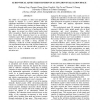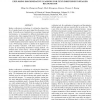631 search results - page 45 / 127 » Learning the Face Space - Representation and Recognition |
CVPR
2006
IEEE
15 years 12 months ago
2006
IEEE
An activity consists of an actor performing a series of actions in a pre-defined temporal order. An action is an individual atomic unit of an activity. Different instances of the ...
CVPR
2007
IEEE
15 years 12 months ago
2007
IEEE
Pattern variation is a major factor that affects the performance of recognition systems. In this paper, a novel manifold tangent modeling method called Discriminant Additive Tange...
ICB
2009
Springer
14 years 7 months ago
2009
Springer
Face recognition with partial face images is an important problem in face biometrics. The necessity can arise in not so constrained environments such as in surveillance video, or p...
ICMCS
2005
IEEE
15 years 3 months ago
2005
IEEE
The ability of a computer to detect and appropriately respond to changes in a user’s affective state has significant implications to Human-Computer Interaction (HCI). To more ac...
ICMCS
2007
IEEE
15 years 4 months ago
2007
IEEE
Speaker verification is a technology of verifying the claimed identity of a speaker based on the speech signal from the speaker (voice print). To learn the score of similarity be...


